Preamble:
For 400 million years that springtails have been evolving on Earth, they have occupied a wide variety of niches. One of the reasons for their survival is their small size that allowed them to colonize interstitial soil, dead vegetation or other confined spaces. On this occasion, they developed specific biological and behavioral adaptation properties.
As I mentioned in the article Springtails are everywhere, they are found in the driest deserts, the coldest areas of the globe, near the highest peaks, the deepest terrestrial cavities in all the expanses of fresh water and at the top of tall trees. The only places where they are not found are deep water and open oceans.
Physiological and / or behavioral factors cause springtails to avoid areas where their survival is impossible:
Physiological avoidance: Relative, for example, to the water permeability of their cuticle (major impact in the desiccation process) or the physicochemical properties of their body fluids (hemolymph) that allow them to avoid freezing when temperatures drop well below 0°C. This is called cryoprotective dehydration "CPD"
Behavioral avoidance:
- Short-term: For example, in coastal species, climbing the flanks of a rock crevice at high tide, to avoid drowning,
- Long term: For example, crawl to the deeper layers of the ground to avoid freezing during the winter.
Finally, some of the most suitable species, can act on a mix these different factors to subsist in the most hostile environments of our planet.
Note: The reading of "Cryoprotective dehydration is widespread in Arctic springtails", a study conducted by Jesper Givskov Sorensen and Martin Holmstrup of the University of Aarhus in Denmark prompted me to write this article to discuss cryoprotective dehydration "CPD".
In order to make my remarks accessible, while taking inspiration from the work of these two researchers, I voluntarily discarded a big part of numerical data, simply to mention the principle of the CPD as a means of survival of some springtails
Introduction :
Cryoprotective dehydration is a cold tolerance strategy adopted by small invertebrates that readily lose water by evaporation when exposed to temperatures below 0°C and in the presence of ice.
In the study that I propose to mention here, the researchers studied the cold tolerance strategy of several species of springtails present in the soil of Arctic Spitsbergen. To do this, they have reproduced in their experience cold and desiccation conditions similar to those endured by these springtails and they compared their water content, their water loss and the melting points of their body fluids.
Reminder: Melting point (MP)
The diagram below shows the different phases of the water according to the atmospheric pressure and the temperature. It illustrates the conditions under which water can be in three different physical states: Solid (ice) - Liquid (water) - Gaseous (vapor).
Relative impact to melting point (PM) :
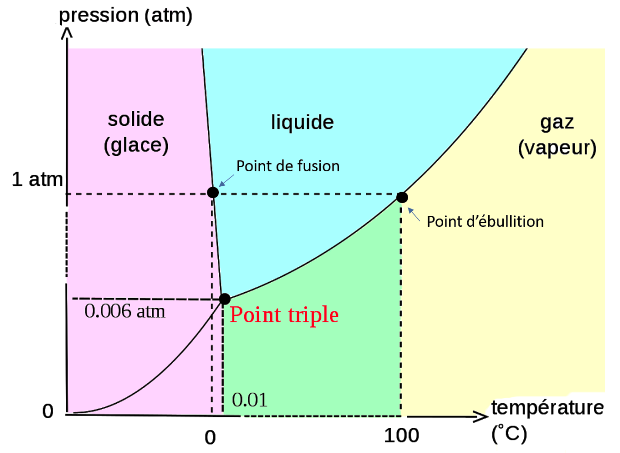 The study of biological fluids shows that they consist of water and other chemical compounds present in various concentrations.
The study of biological fluids shows that they consist of water and other chemical compounds present in various concentrations.
It is precisely the concentration rate of these compounds that plays a major role in their ability to withstand cold.
These compounds have cryoprotective properties comparable to that of the antifreeze that is put in the coolant of our cars to allow it to retain the liquid phase, even under negative temperatures.
In living organisms these compounds are called osmolytes and are present in intracellular solutions.
Extreme conditions:
Collembolans and other terrestrial invertebrates in the polar regions face temperatures well below the melting point (freezing) of their body fluids for many months during which the low availability of liquid, wintry water polar, can cause them to dry out.
The frost-sensitive species have physiological mechanisms that promote supercooling (see zones "C" in fig.1 and fig.2 below) of their body fluids throughout the winter. This strategy allows the water contained in their organisms to be partially preserved. The cuticle of collembola living in the deepest layers of the soil offers little resistance to loss of water by evaporation, which can lead to fatal desiccation.
In fact, the fall in soil temperatures causes the loss of water in the body of collembola, which results in an increase in the levels of sugars and polyols (cryoprotectants) contained in their body fluids. The process of dehydration thus generates, by itself, its own reduction of the risk of freezing through the increase of the concentrations of these substances in the hemolymph. This increase in concentrations makes it possible to lower the melting point of the body fluids, and this, to a large extent, at the same rate as the soil temperatures fall.
At very low temperatures (-15° to -20°C) the water in the cells (osmotically active) is almost completely lost, which means that the body has eliminated the risk of freezing. In return, he must be able to cope with this severe dehydration.
1) Two strategies :
 1.1) Prevention of freezing :
1.1) Prevention of freezing :
Maintenance of biological liquids in supercooling (therefore in the liquid state) up to the lowest possible threshold, beyond which we observe a brutal and fatal freezing.
Between the melting and supercooling points, there is a wide range from -5°C to -28°C (Fig.1 - Zone C)1. In this phase, invertebrates (including springtails) remains alive and enters a state called "permanent torpor". The range of the graph characterizing this state is called "Supercooling Capacity".
At this stage, several physiological mechanisms can interact on the hemolymph, such as for example the production of antifreeze proteins (glycerol, sorbitol ...) or the decrease of the water content by dehydration, with consequent increase of the solute content.
Invertebrates can also choose hibernation sites that are sufficiently dry to avoid contact with external ice crystals that may initiate ice formation within the body.
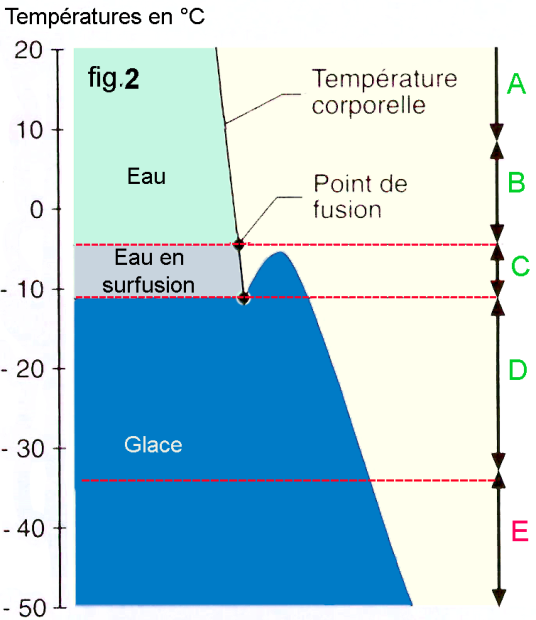 1.2) Resistance to freezing :
1.2) Resistance to freezing :
In relation to the prevention strategy, the freeze resistance strategy has a much smaller amplitude of the supercooling zone (fig.2 - zone C)2. However, zone D, which represents the zone of resistance, makes it possible to reach also very low temperatures.
During this phase D, where the organism can survive, the preferential formation of ice microcrystals outside the cells is observed.
Survival is maintained by a mechanism of redistribution of the water contained in the cell to extracellular fluids which has the effect of restoring the osmotic equilibrium and induces a higher concentration of solutes within the cell.
Legend: A = Infra-optimal activity. B = temporary torpor. C = Permanent torpor or prevention of freezing. D = resistance to freezing. E = Death of the body. *
2) Cryoprotective dehydration :
2.1) Studied springtails :
Animals collected directly from the soils around Ny Alesund were brought back to the laboratory and kept outdoors at temperatures between 1 and 4 ° C.
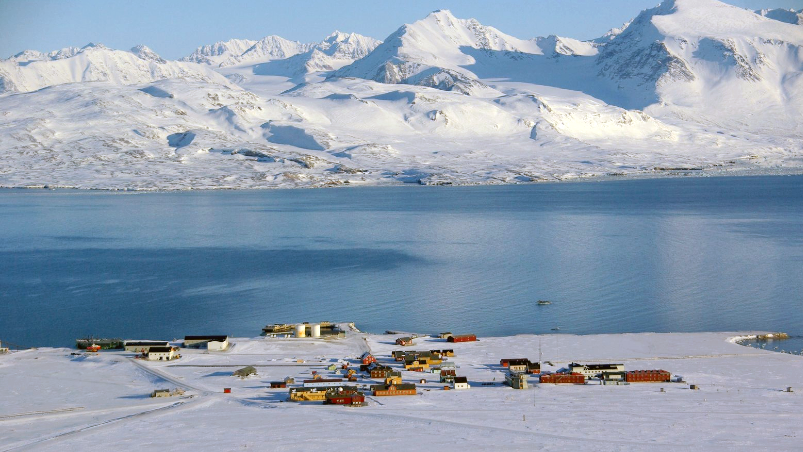
Ny Alesund, located on the Svalbard Archipelago in the Arctic Ocean, between Norway and the North Pole, is the northernmost inhabited village on our planet 4
After identification, five species of springtails (Megaphorura arctica, Folsomia quadrioculata, Hypogastrura viatica, Oligaphorura Tullberg, Isotoma anglicana) were collected in sufficient numbers to allow experimentation. They were then transported to the Silkeborg, Denmark laboratory and acclimatized at 2°C for 4 weeks before continuing the experiment.
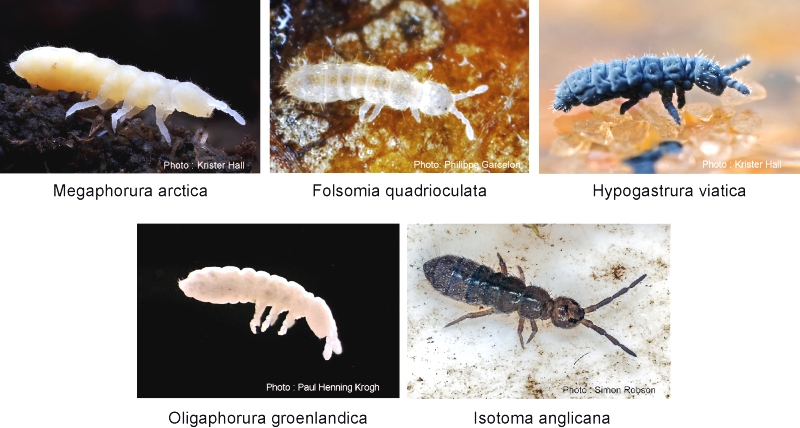
2.2) Dessiccation tolerance :
To determine their desiccation tolerance, fresh animals were placed in flasks placed in a container containing an aqueous solution of NaCl * (water + salt) cooled to + 4 ° C. The relative humidity of the air in this system equilibrates rapidly with the NaCl solution to produce the desired levels of relative humidity (RH).
* Indeed, the use of solutions of NaCl variously concentrated, with melting points corresponding to temperatures below zero, achieves, at + 4 ° C, desiccation forces simulating those that the species meets at during the Arctic winter.
Procedure : The researchers applied to springtails a gradation of drying treatments, using an increasing concentration of NaCl. During the checks, the relative humidity was adjusted to a value slightly above the melting point of the bodily fluids of animals acclimated in summer.
The following graph shows the different drying forces used for the study of springtails.
The following graph shows the temperatures, NaCl concentrations (in gr/liter) and the relative humidity levels (RH) used for the experiment.
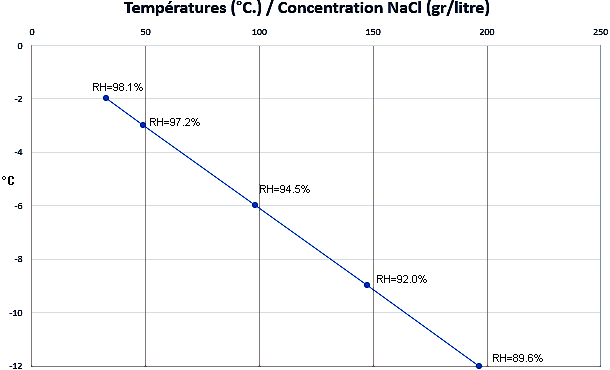
For all these treatments, the samples of each species were exposed to these conditions for 5 days, before the animals were put in a situation to rehydrate for 24 hours, the NaCl solution being then replaced by demineralized water. It was only after these operations that the survival assessments were made, based on the assumption that only animals capable of walking were considered survivors.
Results : This experiment gave first indications on the tolerance to desiccation of the species studied. For example, Megaphorura arctica (diag.1 below) survived desiccation levels of -9 ° C, but did not withstand -12 ° C. Survival of the remaining species has been impacted at drying levels ranging from -6 ° C to -8.2 ° C or even higher moisture levels. Isotoma anglicana (diag.5 below) was affected at relatively low levels of desiccation and had an estimated "LT20" at -3.5 ° C.
NB: LT20 = Critical level of water loss at which a mortality of 20% is reached.
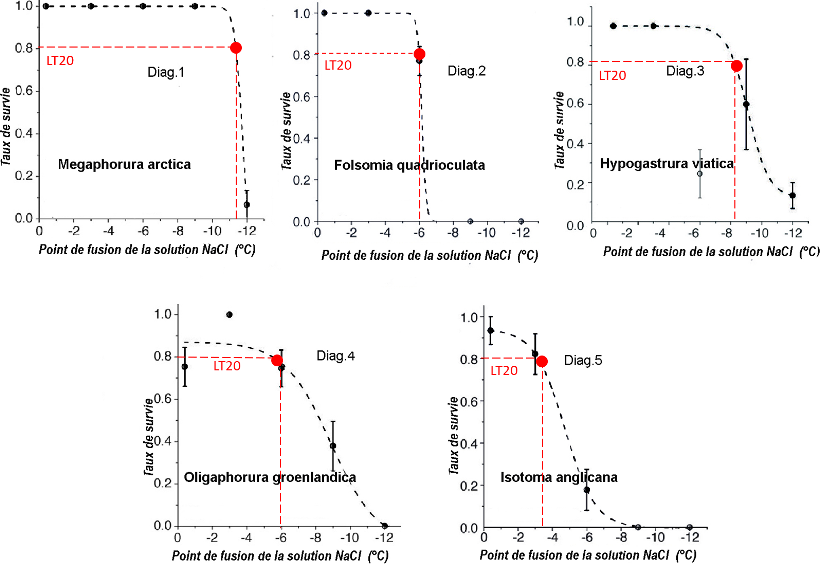
2.3) Effects of desiccation on water content and melting point :
From the desiccation tolerance results, a new experiment was conducted to estimate the water loss and melting point of body fluids resulting from exposure to desiccation levels corresponding to the critical level of water loss "LT20".
Result: In 7 days, all species lost water up to their respective "LT20" levels (or slightly lower levels) with the exception of Hypogastrura viatica which reached its LT20 level only after 14 days. The body melting points of the springtails were therefore comparable with respect to the NaCl solution to which they had already been exposed.
The results indicate that osmolytes were successfully mobilized during dehydration in I.anglicana, H.viatica and F.quadrioculata, and that these substances contributed significantly to the low concentrations observed during desiccation.
Desiccation survival was generally high (between 40 and 80% survival) except for O.groenlandica (23% survival).
2.4) Progressive effects of cryoprotective dehydration :
Another experiment investigated desiccation at temperatures below 0 ° C, causing cryoprotective dehydration with decreasing temperatures in an atmosphere saturated with water vapor or ice. For this, after a gradual lowering of the temperature, the samples were maintained at -2 ° C for 24 h, then cooled, still gradually, from 0.5 ° C per day to -6 ° C, where they are stayed for a week before continuing cooling at the same rate until reaching -12 ° C where they remained for the rest of the experiment.
CPD treatment was sampled after 14 days (corresponding to a cooling phase and holding at -6 ° C for 5 days) and after 33 and 47 days (corresponding to cooling and holding at -12 ° C, respectively). 5 and 19 days).
In all three assessments, researchers determined the survival rates, water content, and melting point of body fluids. Survival was determined after recovery at 2 ° C and 100% RH for 24 h.
Results: Isotoma. anglicana lost little water (~ 23%) during exposure at temperatures below 0 ° C, although the melting points measured were significantly lower than the control value and remained almost constant over the duration of the test. exposure at -12 ° C. (from -1.46 ° C / 33 days to -1.54 ° C / 47 days) under these conditions, survival was about 52%.
Three species recorded high rates of dehydration (F.quadrioculata, M.arctica and O.groenlandica) during cold exposure and their melting point was largely balanced with exposure temperature. H.viatica was also particularly dehydrated during cold exposure. At the last assessment, after 47 days, the observed melting point was below the detection limit (-7.8 ° C). These four species of springtails showed a high level of survival during all exposure to cold (between 62 and 97%).
3 ) Conclusion :
the study I just briefly mentioned has made it possible to highlight the factors that favor the adoption of CPD in the species studied. Firstly, their small size, but also their high water permeability and their ability to tolerate significant or even extreme dehydration. This ability to withstand dehydration is often favored by the accumulation of compatible osmolytes such as sugars and polyols.
Although the Arctic species studied met these criteria, laboratory tests showed that not all of them systematically used a CPD strategy. This was the case of I. anglicana, which had a relatively high survival rate (about 50%) at -12 ° C, but whose resistance was not based on CPD. In fact, at temperatures below zero, this species almost lost no water and the melting point remained high (around -1.5 ° C) throughout the experiment. I.anglicana is a typical example of a species avoiding frost with a high supercooling capacity.
The other four species of springtails (H.viatica, M.arctica, F.quadrioculata and O.groenlandica) all lost significant water content when exposed to temperatures below 0°C. Their melting points seemed to equilibrate with the exposure temperature, indicating that these species did use CPD.
It is a fact that springtails hibernate at the adult or juvenile stage in arctic regions. Until the discovery of the CPD, it was considered that the survival of the latter was due to their ability to implement the process of supercooling. If this is the case as noted in I. anglicana, the results of the study conducted by Jesper Givskov Sorensen and Martin Holmstrup highlight the fact that many small species of springtails hibernate with CPD.
Note:
Although these small animals have not yet revealed all their secrets, and without drawing an early conclusion on the basis of a single study, it now seems established that the DCP is part of the panoply of strategies developed by springtails to withstand intense cold. Other studies also show that during active winter phases in regions where temperatures are less stringent, some springtails also play on the concentration of osmolytes in their body fluids. For example, read this paper by William Bloch and Jorg Zettel about Ceratophysella sigillata.
Sources:
1-2 Diagrammes issus de l'article " Adaptation au froid des invertébrés et cryoconservation des oeufs d'insectes aphidiphages"- E.Branquart, J-L. Hemptinne, C.Gaspar. Cahiers Agricultures 1996;5 : 353-65
3 Journal of insect physiology. 57 ( 2011) 1147-1153 - Cryoprotective dehydrationis widespread in Arctic springtails. Autorisation de reproduction du diagramme 02-07-2019 enregistrée sous le N° 4620611222210. https://www.elsevier.com/fr-fr
4 Image issus du site : https://www.gruan.org/network/sites/ny-aalesund/